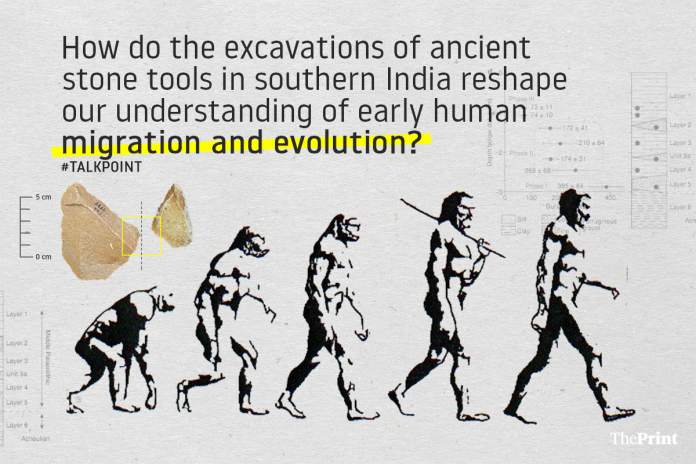New discoveries in Attirampakkam now challenge traditional theories of evolution of ancient stone tools — from big, blunt hand axes into sharply-sculpted stone points. The findings, reported in Nature, upend previous evidences about Middle Palaeolithic culture in India.
You can read what historian Shanti Pappu wrote for ThePrint here.
ThePrint asks: How do the excavations of ancient stone tools in southern India reshape our understanding of early human migration and evolution?
The beginning of the Middle Palaeolithic in the subcontinent has now been pushed back.
 P. Ajithprasad
P. Ajithprasad
Professor and head of archaeology department, MSU, Baroda
These findings are not going to radically change our understanding about the overall picture of cultural and biological evolution of hominins, our ancestors. The luminescence date now places the transition of earlier culture to the MP period somewhere from 3,50,000 years to 1,70,000 years. The early part of these dates is almost contemporary with what we have already known, for similar kind of transition from Africa as well as Europe. This is all based on certain changes in technology used for stone tools.
The paper is a very significant contribution toward this research. We were not very clear about the date. We have been arguing about it. We had given 1,60,000 years to 2,00,000 years generally to the beginning of the Middle Palaeolithic (MP) in the subcontinent. Now, the date has been pushed back. Now, we can look at the new evidence and its antiquity.
But it does not change the ‘Out of Africa’ model, which is based on a set of evidence that includes fossil, archaeological and genetic records. Those converge at the point that most of the modern humans were natives of Africa and spread from Africa — that they emerged 2,00,000 years ago, first spread to West Asia (modern Israel), then spread toward the East, and then West into Europe. That hypothesis remains intact. To replace that, you would need evidence from all these different centres of origin.
However, we need to be a little more cautious about linking the new early date for MP with ‘Out of Africa’ model for modern human dispersal. The paper does not address that issue at all.
The new findings would help us to look at MP technology emerging very early, one would now expect diverse set of technologies from across different regions. The antiquity of this technology could go back to 3,50,000 years, and its independent origin probably emerging from a previous tradition.
We have no fossil records in the subcontinent of archaic or modern humans. We have identified the oldest record to archaic homo sapiens from 1,00,000 years ago.
We know that MP technology certainly originated in Africa, Europe, and now in India. But we have to be cautious to link it to the spread of anatomically modern humans ‘Out of Africa’.
New game-changing excavation will revise the timeframe of ‘Out of Africa’ models
 Ravi Korisettar
Ravi Korisettar
UGC Emeritus Fellow, Department of History and Archaeology, Karnatak University, Dharwad
First of all, let’s examine the evidence from Attirampakkam from the perspective of the monolithic theory of ‘Out of Africa’ expansion and colonisation of contiguous landmasses of Asia and Europe. There are two major events: Out of Africa I and Out of Africa II.
Africa I refers to expansion of Homo erectus around 1.7 million years ago with the stone tool kit comprising handaxes and cleavers, known as Acheulian techno-complex. Africa II refers to expansion of our direct ancestors, Homo sapiens (modern humans), out of Africa around 1,20,000 years ago. Both these models have been debated under ‘long and short chronologies’ based on the dates for the ‘earliest sites’ in Africa. To date, there are no sites outside Africa of equal antiquity either in Europe or Asia, the contiguous landmasses of the Old World.
Africa is rich in palaeo-anthropological sites that have direct association with human fossils and stone tools, with the exception of Lomekwian site in Kenya, which has been dated to 3.3 million years ago. This has pushed the beginning of tool-making to that far back in time. This evidence of man-made stone tools without direct association with any known human ancestor was subject to rigorous peer review process by the journal Nature, and was published because of global significance of the findings for understanding human evolution and the rise of human behaviour. This has led to reshaping our theory of human behaviour in terms of its beginning at least 700 years earlier than the conventional thought that tool making/human behaviour began with the rise of Homo (Homo habilis) around 2.6 million years ago.
During the last five decades, African palaeo-anthropology has produced such game-changer evidence necessitating revision of our understanding of human evolution, even though Spain, Geogria, East and Southeast Asia have produced similar landmark discoveries, the antiquity of African sites has remained older than the rest asserting the monolithic nature of ‘Out of Africa’ model(s). Similarly, the genetic coalescence dates for modern human sites in Africa placed them around 2,00,000 years ago, but the site of Jebel Irhound in Morocco produced (Hublin et al. 2017) a date of 3,00,000 years for the site with fossil remains of Homo sapiens. Thus, pushing the antiquity further back by another 100,000 years.
Continuing research has contributed to reshaping the existing theories for a better understanding of human bio-cultural evolution. I emphasise that all the theories of human evolution have a scientific basis, such as Out of Africa or Multi-regional models, the strength of the theories is governed by the new evidence and the application of modern methods of investigation and the dating methods in particular.
During the last 6-7 years, persistent and single-minded investigations at Attirampakkam have contributed to placing Indian Palaeolithic archaeology at the forefront of human origins debate, contributing to Out of Asia speculations by some workers, but not by the authors themselves.
Be that as it may, in 2011, Attirampakkam produced 1.5 million years ago age to the Homo erectus/Acheulian (Lower Palaeolithic) context, and clearly suggested that Homo erectus left Africa early in the Lower Pleistocene or colonised the Indian subcontinent early in the Lower Pleistocene (2 miollion years ago). This paper was published in Science (Pappu et al. 2011)
Now the same site has produced 385-120 thousand year age for the Middle Palaeolithic, the succeeding phase generally attributed to the rise of the Middle Palaeolithic/Middle Stone Age associated with the rise of modern humans (Homo sapiens).
To date, the oldest Middle Stone Age/Homo sapiens sites in Africa are older (> 400, 000). In 2007, I produced the first oldest date for the Middle Palaeolithic in India (>78, 000 years ago), hinting at the possibility of finding older Middle Palaeolithic sites in India (Jwalapuram in Andhra Pradesh, see Petraglia et al. 2007, in Science).
The implications of Attirampakkam dates for the Middle Paleolithic are (a) the likelihood of Middle Palaeolithic or Middle Stone Age in Africa are older in Africa and the sites are yet not known (b) that modern humans left Africa much earlier than suggested by Out of Africa II, (c) there were multiple expansions of modern humans out of Africa soon after their emergence earlier than 4,00, 000 years ago. Based on this evidence it is too early to dismiss the Out of Africa II, but certainly helps revise the timeframe of out of Africa II and, in this regard, this a game-changer and has contributed much food for thought. This has been published in Nature after rigorous peer review, attesting to its scientific strength and relevance in understanding human exit out of Africa.
The big question is timing of expansion out of Africa, and not other aspects of human evolution, e.g. if human evolution occurred outside of Africa.
Maybe, just maybe, there’s a chance that Stone Age cultures developed here
 Malavika Chatterjee
Malavika Chatterjee
Research scholar, department of ancient Indian history, culture and archaeology, Deccan College Post-Graduate and Research Institute
For years, Indian archaeology has been subject to western ideas and influences especially with regards to human evolution and migration patterns. The recent dates from Attirampakkam (ATM) have revolutionised the way we see the Palaeolithic cultures and their origins. Until now we assumed that the Middle Palaeolithic culture (a stone tool culture developed by archaic or modern humans) in India developed around 140 ka (thousand years ago) and extended till 46 ka. It held up to the western ideas as well as validating their theories regarding human (modern human) dispersals out of Africa.
It is widely believed that around 300-200 ka, a shift in stone tool technology was observed from the Lower Palaeolithic to the Middle Palaeolithic culture in terms of hominin behaviour through technological transformations. The earliest evidence of Homo sapiens comes from a cave site at Jebel Irhoud, Morocco dating to 300 ka, 100 ka older than previously reported. However, paucity of such fossil finds, radiometric dates from excavated sites and geochronological constraints restrict Indian prehistoric research.
ATM provides us with dates over 380 ka, which discredits the theory that modern human dispersals from Africa began around 125 ka or later. Although, not much can be said about the origins of this culture being native but it certainly sheds light on the possible interaction between modern humans and archaic humans. This find also suggests that South Asia itself would have witnessed dispersals resulting in regional variation of the stone tool technology.
So, we have one of the oldest of the Lower Palaeolithic levels from Attirampakkam of 1.7 ma (million years ago) and the oldest Middle Palaeolithic dates as well. Maybe, just maybe there’s a chance that these Stone Age cultures developed here.
The second expansion outside Africa may have occurred in or close to the Indian subcontinent
B.N. Sarkar
Former superintending anthropologist, Anthropological Survey of India, Kolkata
The findings of the article titled ‘Early Middle Palaeolithic culture in India around 385-172 ka reforms Out of Africa models’ published in Nature, February 2018 is commendable. It probably is the only decent source of information, pertaining to long-range migration of the prehistoric people in India.
As much as I loved this article, there were some curious problems that I noticed concerning the paucity of excavated materials for addressing this issue. People migrate because of pulls from their destination and pushes in their homeland, often propelled along by some technological advantage. People have, of course, migrated out of India as well, but these out-migrations have been on a much smaller scale. This is obviously related to the fact that India had been the site of many, significant technological innovations which propelled major early migrations in this subcontinent.
This is in conformity with the current view that modern Homo sapiens populations underwent a first expansion within Africa and a second expansion outside Africa — an expansion that may have occurred in or close to the Indian subcontinent itself.
Such significant findings will certainly help us understand the origin and population movement in the Indian subcontinent during the prehistoric times. This may be confirmed with the findings of other disciplines, including the recent ancient genomic evidence.






